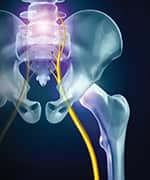LIFE EXTENSION MAGAZINE
A March 2022 study published in the Pain Journal revealed a striking statistic:
More than one in five U.S. adults reported suffering from chronic pain.1
Pain medications can help temporarily. But long-term use poses health risks.
A safer alternative is needed. That is where PEA comes in.
Palmitoylethanolamide, or PEA for short, is a fatty acid made in the body.
Scientists have found that it works in unique ways to reduce inflammation and relieve pain—without worrisome side effects.2
In human trials, PEA has been shown to reduce pain associated with common conditions, including:2-9
- Arthritis,
- Sciatica,
- Migraine headache,
- Carpal tunnel syndrome, and
- Other types of nerve and joint pain.
In a study of people suffering from jaw joint pain, just two weeks of PEA use resulted in greater pain reduction and improvement in jaw mobility than high-dose ibuprofen.10
The Problems with Pain Medications
Two common classes of medication used to treat pain are non-steroidal anti-inflammatory drugs (NSAIDs) and opioids.
NSAIDs include over-the-counter drugs like ibuprofen (Advil®, Motrin®), naproxen (Aleve®), and high-dose aspirin.
These drugs can be effective at managing some forms of inflammation-related pain, but they come with side-effect risks.
Even short-term use of some NSAIDs has been found to be associated with increased risk of heart attack and stroke.11-13
Opioid medications are even more problematic because they are side-effect prone and often addictive.14-16
The leading cause of acute liver failure in the United States is acetaminophen toxicity.17 Regular use of acetaminophen is associated with increased risk of kidney damage, kidney cancer, and dementia.18-20
Scientists began looking for a safer way of controlling pain. They found it in palmitoylethanolamide (PEA), a compound produced in the body.
PEA and Inflammation
PEA is a fatty acid found in the body that lowers inflammation.
Animal studies show that PEA modulates inflammatory and oxidative pathways and significantly relieves chronic inflammatory and neuropathic pain.21,22
Several clinical trials have established the validity of PEA as a powerful pain reliever.8,23
Unlike commonly used pain-relieving drugs, PEA has no documented cardiovascular or renal risk.8 Clinical studies on PEA highlight its safety and efficacy even when used in combination with common pain relievers.4,6
Reducing Chronic Pain
Several human studies have evaluated the ability of PEA to control chronic pain.
One of the most remarkable findings coming out of these studies is that PEA is effective at reducing pain for a wide range of underlying conditions, including:
- Headache,
- Nerve pain,
- Joint pain,
- Back pain, and
- Other types of pain.
In patients with knee osteoarthritis, both 300 mg and 600 mg of PEA taken daily led to significant reductions in pain scores compared to a placebo.3 PEA also significantly reduced scores on various scales evaluating joint stiffness, improved knee function, and reduced anxiety.
Sciatica is extremely common. Irritation of the fibers of the sciatic nerve running down the back of the leg can cause severe pain in the lower back, leg, and foot.
In a study, 636 patients with sciatica were randomized to receive either 300 mg or 600 mg daily of PEA or a placebo.4 Both groups receiving PEA had improvements in pain and quality-of-life scores compared to placebo. Those taking the highest dose improved the most.
One study directly pitted PEA against ibuprofen, one of the most-used NSAIDs.10
People suffering from temporomandibular joint pain (affecting the joints of the jaw) received either PEA (300 mg in the morning and 600 mg at night for one week, followed by 300 mg twice a day for the second week) or high-dose ibuprofen.
What you need to know
Fighting Pain with PEA
- Chronic pain is estimated to affect more than one in five adults in the U.S.
- Common pain medications such as opioids and nonsteroidal anti-inflammatory drugs (NSAIDs) are associated with serious health risks.
- Researchers have identified the fatty acid palmitoylethanolamide, or PEA for short, that works to reduce pain and harmful inflammation.
- Clinical studies of a wide range of pain types have shown that PEA intake relieves pain without harmful side effects.
- In one head-to-head study, two weeks of PEA intake led togreater pain reduction than the popular NSAID ibuprofen.
After two weeks, PEA resulted in greater pain reduction and improvement in jaw mobility than ibuprofen.
It doesn’t stop there. Studies evaluating migraine headaches, carpal tunnel syndrome, arthritis, and a wide range of other types of pain have found that PEA significantly reduces pain intensity.2,3,5-9
In one study, patients with chronic pain who could not achieve adequate control using standard pain medications were given 600 mg of PEA twice a day.2 This treatment reduced pain scores in all patients who completed the study, regardless of their underlying condition.
All these studies found PEA to be well-tolerated with practically no side effects.
Summary
Chronic pain is extremely common, but medications to treat it are too often ineffective and carry troublesome side effects.
Three classes of common pain drugs, NSAIDs, acetaminophen, and opioids can have significant and potentially life-threatening side effects.
Scientists have identified a natural fatty acid called PEA that acts by several mechanisms to reduce pain and inflammation.
Several human clinical trials have shown that PEA can help treat a wide range of pain types, without dangerous side effects.
If you have any questions on the scientific content of this article, please call a Life Extension Wellness Specialist at 1-866-864-3027.
References
- Yong RJ, Mullins PM, Bhattacharyya N. Prevalence of chronic pain among adults in the United States. PAIN. 2022;163(2).
- Gatti A, Lazzari M, Gianfelice V, et al. Palmitoylethanolamide in the treatment of chronic pain caused by different etiopathogenesis. Pain Med. 2012 Sep;13(9):1121-30.
- Steels E, Venkatesh R, Steels E, et al. A double-blind randomized placebo controlled study assessing safety, tolerability and efficacy of palmitoylethanolamide for symptoms of knee osteoarthritis. Inflammopharmacology. 2019 Jun;27(3):475-85.
- Guida G, De Martino M, De Fabiani A, et al. La palmitoiletanolamida (Normast®) en el dolor neuropático crónico por lumbociatalgia de tipo compresivo: estudio clínico multicéntrico. Dolor. Investigación Clínica & Terapéutica. 2010;25:35-42.
- Artukoglu BB, Beyer C, Zuloff-Shani A, et al. Efficacy of Palmitoylethanolamide for Pain: A Meta-Analysis. Pain Physician. 2017 Jul;20(5):353-62.
- Chirchiglia D, Cione E, Caroleo MC, et al. Effects of Add-On Ultramicronized N-Palmitol Ethanol Amide in Patients Suffering of Migraine With Aura: A Pilot Study. Front Neurol. 2018;9:674.
- Conigliaro R, Drago V, Foster PS, et al. Use of palmitoylethanolamide in the entrapment neuropathy of the median in the wrist. Minerva Med. 2011 Apr;102(2):141-7.
- Gabrielsson L, Mattsson S, Fowler CJ. Palmitoylethanolamide for the treatment of pain: pharmacokinetics, safety and efficacy. Br J Clin Pharmacol. 2016 Oct;82(4):932-42.
- Petrosino S, Di Marzo V. The pharmacology of palmitoylethanolamide and first data on the therapeutic efficacy of some of its new formulations. Br J Pharmacol. 2017 Jun;174(11):1349-65.
- Marini I, Bartolucci ML, Bortolotti F, et al. Palmitoylethanolamide versus a nonsteroidal anti-inflammatory drug in the treatment of temporomandibular joint inflammatory pain. J Orofac Pain. 2012 Spring;26(2):99-104.
- Bally M, Dendukuri N, Rich B, et al. Risk of acute myocardial infarction with NSAIDs in real world use: bayesian meta-analysis of individual patient data. BMJ. 2017 May 9;357:j1909.
- Park K, Bavry AA. Risk of stroke associated with nonsteroidal anti-inflammatory drugs. Vasc Health Risk Manag. 2014;10:25-32.
- Walker C, Biasucci LM. Cardiovascular safety of non-steroidal anti-inflammatory drugs revisited. Postgrad Med. 2018 Jan;130(1):55-71.
- Rudd RA, Aleshire N, Zibbell JE, et al. Increases in Drug and Opioid Overdose Deaths--United States, 2000-2014. MMWR Morb Mortal Wkly Rep. 2016 Jan 1;64(50-51):1378-82.
- Scholl L, Seth P, Kariisa M, et al. Drug and Opioid-Involved Overdose Deaths - United States, 2013-2017. MMWR Morb Mortal Wkly Rep. 2018 Jan 4;67(5152):1419-27.
- Wilson N, Kariisa M, Seth P, et al. Drug and Opioid-Involved Overdose Deaths - United States, 2017-2018. MMWR Morb Mortal Wkly Rep. 2020 Mar 20;69(11):290-7.
- Available at: https://www.mayoclinic.org/diseases-conditions/acute-liver-failure/symptoms-causes/syc-20352863. Accessed October 13, 2021.
- Kanchanasurakit S, Arsu A, Siriplabpla W, et al. Acetaminophen use and risk of renal impairment: A systematic review and meta-analysis. Kidney Res Clin Pract. 2020 Mar 31;39(1):81-92.
- Choueiri TK, Je Y, Cho E. Analgesic use and the risk of kidney cancer: a meta-analysis of epidemiologic studies. Int J Cancer. 2014 Jan 15;134(2):384-96.
- Jones GR. The Alzheimer pandemic: is paracetamol to blame? Inflamm Allergy Drug Targets. 2014 Feb;13(1):2-14.
- Seol TK, Lee W, Park S, et al. Effect of palmitoylethanolamide on inflammatory and neuropathic pain in rats. Korean J Anesthesiol. 2017 Oct;70(5):561-6.
- Petrosino S, Cordaro M, Verde R, et al. Oral Ultramicronized Palmitoylethanolamide: Plasma and Tissue Levels and Spinal Anti-hyperalgesic Effect. Front Pharmacol. 2018;9:249.
- Paladini A, Fusco M, Cenacchi T, et al. Palmitoylethanolamide, a Special Food for Medical Purposes, in the Treatment of Chronic Pain: A Pooled Data Meta-analysis. Pain Physician. 2016 Feb;19(2):11-24.






